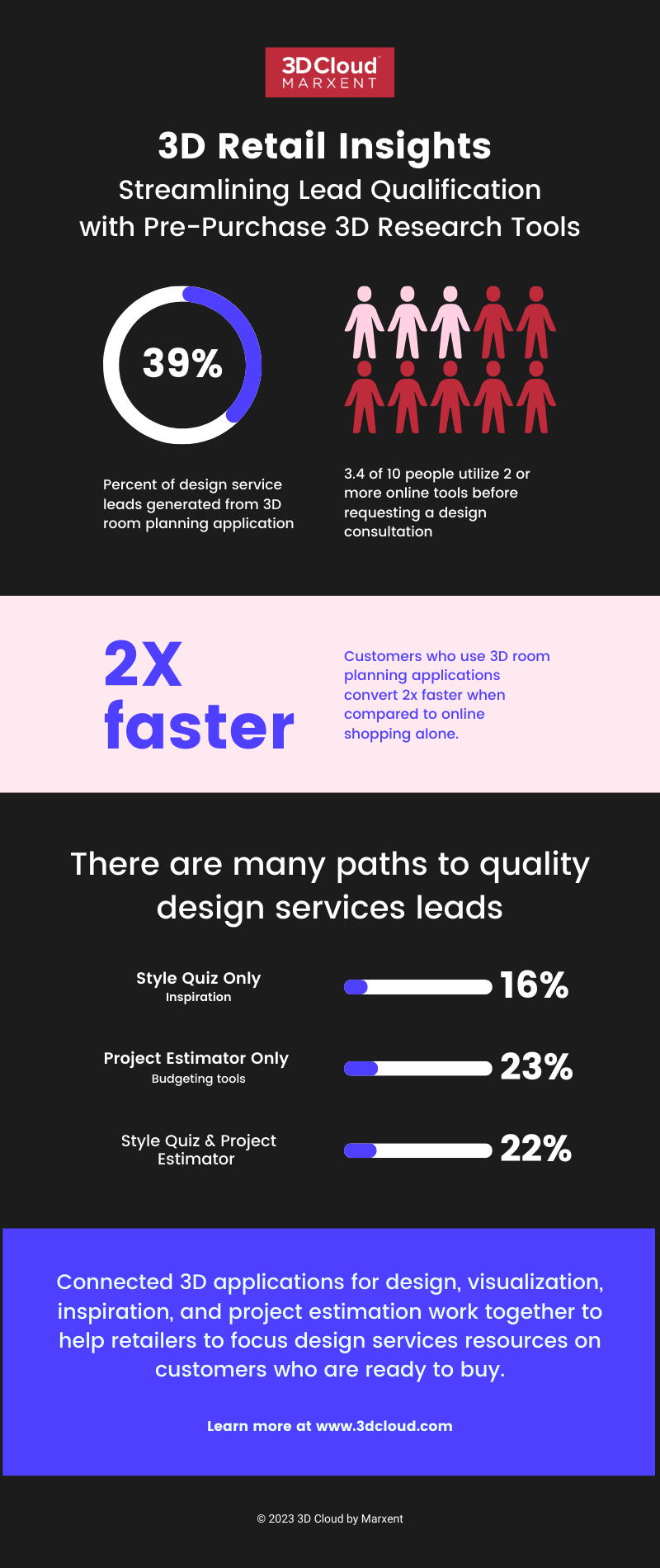
Download PDF Infographic
Download PNG
If you are an e-commerce, digital, marketing, design services, or customer experience leader, this article is for you.
This article covers:
Imagine this scenario: Chloe, a discerning shopper with a passion for home improvement, is on the hunt for the perfect piece of furniture to complete her newly renovated living room. Chloe’s journey didn’t begin when she walked into a furniture store; it started weeks ago, from the comfort of her own home. She spent countless hours exploring a retailer’s website, meticulously configuring various furniture pieces, and even using a 3D room planning application to visualize how they would fit in her actual living space. The only thing left for her to assess in person was the feel and comfort of the furniture.
Chloe’s journey: A window into modern buying
Chloe is not an isolated case. In fact, she represents a growing number of customers who are well into their buying journey before setting foot inside a store. As we explore the impact of 3D applications on lead qualification and resource optimization, Chloe’s story provides a compelling illustration of the evolving retail landscape.
The bargain hunter, the educated customer, and the impulse buyer all share one thing in common: If they need a new sofa, chair, bedroom set, or kitchen remodel eventually they are going to buy. The question is when and how much time to spend with each shopper during each phase of their journey.
Customers are in a buying cycle long before they enter a store
Like Chloe, many customers who are ready to buy high ticket items such as furniture or DIY projects such as kitchen and bath remodels have often done a significant amount of online research before visiting a store.
Though less than 30 percent of furniture sales happen online, according to Statista Digital Market Insights, nearly 90 percent of customers start shopping for furniture online, according to a recent webinar from the Home Furnishings Association. That’s right. There’s a good chance that 9 out of 10 people who walk into your store have already shopped online — and Chole was one of them.
While most furniture sales still happen in stores, retailers need a solid strategy for engaging customers online prior to their store visits.
Many retailers are turning to 3D design, visualization, and inspiration tools to provide a unified series of experiences that support customers at various stages of the buying cycle.
- 90% of customers start shopping for furniture online. (HFA webinar)
- Customers visit fewer than 2 stores before making a purchase (HFA webinar)
- Less than 30% of furniture sales happen online (Statista Digital Market Insights)
The power of 3D in Chloe’s story
Chloe’s online interactions with the retailer’s website were not just casual browsing; they were significant steps in her journey that also served as buying signals. Her engagement with 3D applications, particularly the room planning tool, allowed her to visualize her dream living room and confirm that the chosen pieces would harmonize perfectly with her space.
3D apps: Identifying serious buyers
Chloe’s extensive online engagement serves as a clear indicator of her intent to purchase. When she finally walks into the physical store, she’s not merely a warm lead; she’s a hot prospect ready to make a buying decision. This is where 3D applications shine, guiding retailers to identify and engage with customers exhibiting strong buying signals, just like Chloe.
Efficiency and labor savings
Retailers can strategically leverage 3D applications and other online tools to streamline lead generation for shoppers of all profiles. By providing a range of experiences that cater to customers at various stages of their buying journey and tailored to their specific preferences, retailers can increase the likelihood of conversion while efficiently allocating resources. In other words, sales colleagues can spend more time on the people who are most likely to transact in the near term.
Measuring the impact of 3D
Chloe’s story serves as a real-world example of how these applications can transform casual website visitors into high-quality leads.
With a series of connected applications that engage customers with the right experience at the right time, combined with a lead scoring framework, retailers can easily gauge the customer’s purchase intent and steward their resources accordingly.
Quantifiable impact of 3D on lead generation
In a previous article, we shared our Virtual Design Services Lead Quality Framework for lead scoring. Working in concert together, inspiration, estimation, 3D design and 3D configuration tools help to qualify leads. This is the percentage of leads that converts to sale from one or more application:
- 27% from 3D room planner only
- 23% from project estimator only
- 22% from project estimator & style quiz
- 16% from style quiz only
- 5% from project estimator & 3D room planning
- 4% from project estimator, style quiz, & 3D room planner
- 3% from style quiz & 3D room planning
How to determine which tools a customer has engaged with
In an ideal scenario, a customer profile travels with the shopper throughout their experience. They can use an online tool and share the results with a sales associate in-store — in an entirely connected, personalized experience. But even without this level of sophistication, there are ways to capture 3D engagement and attribute it to sales and utilize the information to make choices about where to spend design services time.
- For leads directed to virtual design teams, include a question on the submission form to gather insight on which 3D tools they used prior to submitting their request.
- A furniture store associate can incorporate questions shortly after a customer’s arrival that indicate whether a customer in-store has already engaged with 3D applications such as WebAR, 3D product configurators, or 3D room planning tools.
- A design team member can be more selective with committing to measurement appointments when they know a customer has already interacted with and engaged with their 3D applications.
Harnessing the potential of 3D applications not only streamlines lead generation but also empowers your organization to focus on high-quality leads, ultimately saving you time and money in the process.
Downloadable infographic
We’ve developed an infographic on the quantifiable impact of 3D pre-purchase research tools on lead generation. How to use this infographic:
- Use it to develop and evaluate 3D app investments tied to lead generation for design services and in store associates.
- Leverage it as supporting materials for your business case for investment.
- Educate your team on the interplay between buying stages, 3D applications, and design services lead quality.
Download the 3D Retail Insights: Streamlining Lead Qualification with Pre-Purchase 3D Research Tools
Download PDF Infographic
Download PNG
Better customer relationship marketing opportunities and better conversion rates can occur when leveraging 3D experiences and lead scoring. Better quality leads mean happier customers who turn into brand advocates, more productive designers and store associates who can spend time building relationships and focusing on deals with a higher likelihood of closing, and a boost to the bottom line.
Contact Us for a customer journey analysis or Request a Demo.














